Katie M. sent in a link to a post at Vast Public Indifference about gender in Pixar films, specifically how they tend to focus on male characters, with female characters in smaller or supporting roles. As Caitlin says in the original post,
The Pixar M.O. is (somewhat) subtler than the old your-stepmom-is-a-witch tropes of Disney past. Instead, Pixar’s continued failure to posit female characters as the central protagonists in their stories contributes to the idea that male is neutral and female is particular. This is not to say that Pixar does not write female characters. What I am taking issue with is the ad-nauseam repetition of female characters as helpers, love interests, and moral compasses to the male characters whose problems, feelings, and desires drive the narratives.
Here are some images showing main characters from a number of Pixar films. Clearly there are a lot I left out; I chose these both because they were mentioned in the original post by Caitlin, because I’ve seen them, and because they illustrate the general trend.
From “Cars,” a movie in which almost all the characters are male and female characters are mostly car-groupies who swoon over the main character (though there is a female attorney car who doesn’t fall into that category):
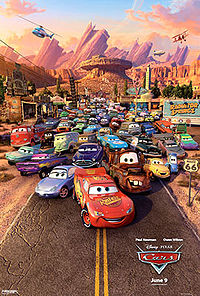
“Monsters, Inc.,” where the two central characters are male:
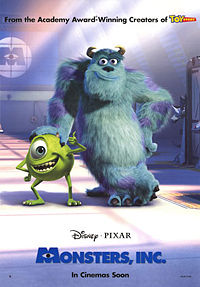
“Toy Story,” same as above:
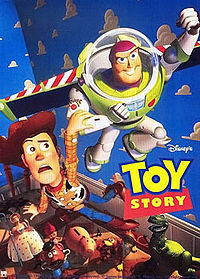
“A Bug’s Life,” in which not only is the main character male, the actual behaviors of male and female ants have been switched to fit in with our ideas of appropriate gender roles (for another example of changing the behavior of animals to fit human gender norms, see this post on “Bee Movie”):
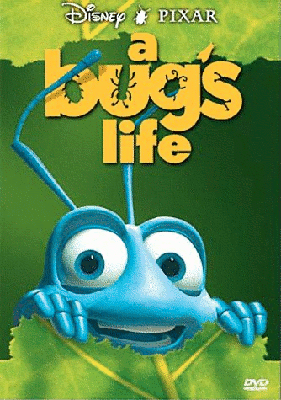
We do see a Pixar film with a female main character, however: the upcoming”The Bear and the Bow”:
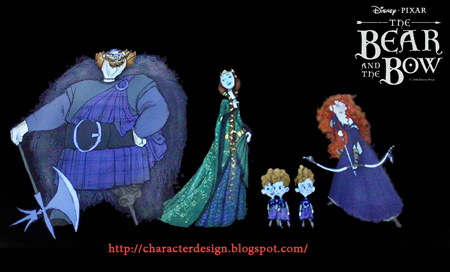
According to Wikipedia, this is Pixar’s “first fairy tale.” So apparently though we get a female lead here, she’s of the spunky-princess type often found in fairy tales.
I have read, in discussions of gender in children’s films, that there is a general belief in the industry that everyone will watch a movie with a male lead character, but boys will be turned off by movies with a female lead. So we see the pattern Caitlin points out: males are the neutral category that are used when the movie is meant to appeal to a broad audience, while females get the lead mostly when the movie is specifically geared toward girls. The assumption here is that girls learn to look at the world through the male gaze (identifying with and liking the male lead, even though he’s male), while boys aren’t socialized to identify with female characters (or actual girls/women) in a similar manner.
I’m torn as to whether I think boys would avoid movies that had female leads. On the one hand, a big part of masculinity is rejecting all things feminine, so I can imagine boys deciding they hated any movie that seemed to be for or about girls. On the other hand, I wonder what would happen if we had more films aimed at kids that had female leads but didn’t fall into the traditional “girl’s movie” categories (such as fairy tales). If “A Bug’s Life” had a female lead but was otherwise the same type of movie–one aimed at a general audience, not specifically girls–would boys reject it? Most of the animated movies I can think of that had females as the main character were focused around romance and other topics deemed feminine (except maybe “Mulan,” where that’s not the main focus), which obscures the issue of whether boys would watch a movie with a female character if it was treated as a general-audience movie. [Note: See the comments for some other examples of movies with female leads that weren’t necessarily romantic-centered, such as “Lilo & Stitch” and “Alice in Wonderland,” as well as some non-animated ones.]
I dunno. Thoughts?
UPDATE: In the comments, Benjamin L. makes a great point:
Something to consider is that most of the people working on Pixar films are men. It’s possible that they might feel unable to successfully create and write dialog for compelling female characters. Take a look at this list: http://en.wikipedia.org/wiki/List_of_Pixar_films Out of the all the writers and directors of Pixar’s films, one is female–Rita Hsiao. Significantly, the films she has worked on, Mulan and Toy Story 2, are unique in that they both have prominent female characters.

Comments 50
Martin — March 22, 2009
"Most of the animated movies I can think of that had females as the main character were focused around romance and other topics deemed feminine"
"Lilo and Stitch" is great, and two of the three main characters are female.
Astraea — March 22, 2009
I’m torn as to whether I think boys would avoid movies that had female leads. On the one hand, a big part of masculinity is rejecting all things feminine, so I can imagine boys deciding they hated any movie that seemed to be for or about girls.
I don't know about how many boys enjoyed or rejected The Golden Compass, but its box office success should have rendered that moot. Also, Lilo and Stitch, as Martin mentioned. But of course Hollywood has never been quick to learn those lessons. I suspect that not being willing to make a movie that boys might not like is not entirely about the hypothetical low profit.
Benjamin Lobato — March 22, 2009
Something to consider is that most of the people working on Pixar films are men. It's possible that they might feel unable to successfully create and write dialog for compelling female characters. Take a look at this list:
http://en.wikipedia.org/wiki/List_of_Pixar_films
Out of the all the writers and directors of Pixar's films, one is female--Rita Hsiao. Significantly, the films she has worked on, Mulan and Toy Story 2, are unique in that they both have prominent female characters.
Maybe when there is a more equal distribution of gender in the animation industry, things will start to turn around.
Ross — March 22, 2009
What about Alice in Wonderland? There is no theme of romance in that one. And being male and having male friends everyone has loved that film. And that is a classic and not a fairy tale, in that it is not traditional such as Snow White. No male is afraid to admit that they liked that movie even as kids. If you move out of animated Labyrinth had a female lead and even though it was not a financial success (which may or may not be due to a female lead) was also a childhood favorite amongst my male friends and I.
Or even in TV (being a child of the 80s) when She-Ra came on and replaced He-Man. It even lasted 30 more episodes then He-Man. I know alot of my male friends watched it when we were kids and that was a female led animated show.
adam — March 22, 2009
I think one has to factor in age groups. Once (heterosexual) males reach puberty and start to develop sexual interests in girls/women, I think they sometimes are more likely to identify with them (at least if they are sexy/spunky--which is a whole nother issue).
You can see this with horror movies of boys identifying with the "final girl" (although thee are debates around what this means). Also, in a lot of video games like MMORPGs, males will choose a female avatar/alias. There are also shows like Buffie that have a pretty big male audience. [Something I just thought of: a few years ago two major games were being released by Ubisoft: Prince of Persia and Beyond Good and Evil (a 'Zelda clone'). Both got very strong reviews, but BGE bombed in the first month and had dropped from a $50 price tag to a $20 one--which is why I bought it. [and let me say it is one of my favorite games to this day!] BGE had a strong (but not sexy) female protagonist with male helpers, but to this day PP--a huge success--still has a very arrogant male lead... Perhaps gender played a role in sales?]
But then again, these are more niche sectors of entertainment that is usually predominated by "nerds," "geeks," etc not necessarily "jocks" who are more associated with the American mainstream. It's like a vicious cycle, the less female leads in popular films and narratives, the less female empowerment, the more misogyny, the less popular said stories become, the less films of that sot of made, etc... It's one way in which the free market has not helped the feminist cause, I suppose.
adam — March 22, 2009
Oh yeah, I just thought of another popular film with two female leads: Pan's Labyrinth, and also The Labyrinth for that matter (which may only be popular because of Bowie). But I think the reason goes back to the fact it shares a horror and fantasy/fairy tale genre. As long as there is violence, many guys will watch it.
But this goes back to genres. It seems that female protagonists are much more accepted in science fiction, fantasy, and horror than say realist/naturalist genres. So guys (generally speaking) are okay with viewing female protagonists in unrealistic stories. Maybe that explains Ross' point that so many guys love Alice and Wonderland--because it's not real!
Esme — March 22, 2009
When I went to see Coraline, at least half the children in the audience were male, and they were very vocal about their enjoyment of the film.
AL — March 22, 2009
I think the key would be to not make ever movie with a female lead be about "girl stuff." As others mentioned above, there have been some movies in which that wasn't the case, but it's far from being the norm.
At one time when I was growing up, I remember thinking, should I be a boy? because I identified much more with aladdin than jasmine. Now I realize it was aladdin's agency that I admired.
Dubi — March 22, 2009
Look at the 100 biggest grossing movies in history(*). How many of these had a woman lead (read: first billed)? Well, there's My Big Fat Greek Wedding (#54). And that's IT.
So, why are we complaining specifically about Pixar? Women leads are in chic flicks. That's the general rule in Hollywood. That may very well be a problem, but targeting Pixar specifically strikes me as odd.
* http://www.movieweb.com/movies/boxoffice/alltime.php - US only. Really Bruce Almighty #51? You serious?
genderkid — March 22, 2009
Gender-nonconformity in Pixar movies is severely repressed. In A Bug's Life, Francis the ladybug overacted the stereotypes of masculinity in order to be seen as male:
"Francis is frustrated by constantly being mistaken for a female; an obvious pun on the name of his species. In such frustrations, he is shown to be belligerent and aggressive to the point of frightening others."--Wikipedia
Cat — March 22, 2009
What about WALL-E? Sure, at first you see the story as boy robot falls in love with girl robot. But really? There aren't any references to gender/sex by the characters at all.
Read this post "WALL•E: A Butch/Femme Love Story... or Silly Rabbit! Robots Have No Gender" by Kate Bornstein for more: http://katebornstein.typepad.com/kate_bornsteins_blog/2008/07/walle-a-butchfe.html
supernora — March 22, 2009
i think its more about the parents response to how their children accept a film than it is the children. if youve ever spent time around a little kid, they really dont care until you make them feel bad about it. little boys loved dora the explorer when she first came out. then a spin off show with a male lead was created in response. a lot of parents didnt want their little boys imitating a girl.
Liz — March 22, 2009
Thank you. Thank you. Thank you for bringing this up. This is a huge pet peeve of mine.
I'm a huge Pixar fan (well of Finding Nemo, The Incredible's & Monsters, Inc.) but can't support them because of awful movies like Ratatoille. Brad Bird has some serious issues with needing to be seen as a manly man's man, whose a man.
And as the differences between what boys want to see and what girls want to see, supernora said it, me thinks its primarily guilt and peer pressure.
When it comes down to it most children I've met, or have known when I was a kid, enjoy "girl films" and "boy films" about evenly with little gender related division. Most of the preferences I've noticed are genre prefs, some prefer sci-fi's and some westerns, some comedies and some tales.
Vesko J — March 22, 2009
Non-Pixar animations have much more stereotypes.
One of the latest - Fly me to the moon - has a few adventurous boy-flies go to the moon. No girls allowed in the adventure; in addition - the boys' mother is emotional and constantly faints thinking of the dangers they may face.
A story with girl protagonists is WITCH - a comic book which the boys in my school (12 years old) liked a lot (although feeling ashamed that there is not even one boy in the story to associate with; boys were there only as love interests :)) Still, the boys followed the series for quite a long time.
Tim M — March 22, 2009
I think Beyond Good and Evil (the game) and Prince of Persia are different cases because they are different types of game. Prince of Persia was considered innovative for its fluid 3D parkour platforming and continued a franchise older gamers would be familiar wtih, while Beyond Good and Evil wasn't so much innovative as it was well put together, a great example of the action adventure genre, and was a new franchise.
In the video game industry, it's very risky to sell a new game based on an unestablished intellectual property. That's why so many games are licensed (sports games, games based on movies), sequels, or make close ties to past successful games (Spore gets plastered with stickers saying it was made by creators of SimCity and The Sims).
However, it might be interesting to see which games starting with an unestablished property succeeded and which ones failed, throwing out games deemed mediocre by the critics (Less than 6.5/10) that sold poorly (games hated by critics that sell well can be counted, as it's shown they had merit in other ways to the public, possibly based on the property alone).
Gwen Sharp, PhD — March 22, 2009
Dubi--what strikes me about Pixar is that, in general, they make really interesting, inventive films that aren't trite, don't assume the audience is dumb, and engage both kids and adults. I have really liked quite a few of their films. It just annoys me that while doing lots of innovative, creative things, they can't also manage to break out of this pattern a little bit more.
But mostly I thought the original post was interesting, and it was about Pixar specifically, and we've posted about Disney in the past, so I didn't want to repeat the comments we've made about Disney...thus, the focus on Pixar.
Penny — March 22, 2009
My daughter saw Finding Nemo when she was about 4, and I was surprised to discover afterwards that she assumed Nemo was a girl--there are a few dialog clues that Nemo is supposed to be male (masculine pronouns and Marlin does say "son"), but not many others--with a piping voice, no clothing cues, and a name that doesn't strongly identify gender, she was able to make that leap, and the plot allowed it. When I think "why do all the girls have to be princesses," I remind myself that they don't have to be--and with a little creativity and intent, animated characters like Nemo could have far more flexible identities.
Elena — March 22, 2009
I'd like to add that Hayao Miyazaki has a good track record with female protagonists -- Spirited Away and Howl's Moving Castle (and Princess Mononoke, where the two protagonists, one boy, one girl are at the same level) are recent films, but some other older ones incude Nausicaä of the Valley of the Wind, My Neighbor Totoro and Kiki's Delivery Service, all of them girls as main characters.
MissPrism — March 22, 2009
Nick Park's Chicken Run has mostly female characters.
Marianne — March 22, 2009
I've often noticed the same thing, and I'm glad that you're talking about it. Although there ARE examples to the contrary, for the vast majority, a lot of films for kids or otherwise have a male protagonist that everyone is supposed to identify with. And usually when the lead is female she's a sexy uberwoman. I feel like this tendency is also true in cases of race, where the Caucasian characters are the default, and that is pretty frustrating as well.
Kathryn — March 23, 2009
@Elena
I love studio gibhli partially because it features demale characters that are concerned with so many other things instead of just romance. However, if you've read the book of Howl's Moving Castle you see a much stronger, more determined Sophie who is certainly guilty of bullying people at times with two sisters who are also strong, individual characters, plus Howl's sister, Mrs Pentsimmon and the witch of the waste half of whom are left out, the other half have their characters re-written in the film. All of which made me wonder if there is a limit to how studio gibhli heroines are allowed to behave and be represented.
Anonymous — March 23, 2009
Barnyard was impressive for its transsexual cow/bull creature.
Elena — March 24, 2009
@Kathryn: Yeah... adaptations. Miyazaki's son was the one responsible for the animated Earthsea adaptation that turned everyone's skin a few shades lighter than LeGuin intended, too.
Fat Angie — March 24, 2009
One comment about gendered ants in "A Bug's Life"- the worker ants were split 50/50 with gender, probably because drone ants would look too scary on the screen. Antz (not Pixar) did the same thing with gendered ants. I've studied entomology, I know this is crap. But I don't expect a movie where a lepidopteran has a mantid for a spouse to be exactly great on the biology of things.
I think the reason for using an "everyman" instead of an "everywoman" is because women, being women, have specific experiences as women. A female character is aware of her gender. An everyman character can have both male and female experiences, and become somewhat androgynous (ie. Nemo).
It's privilege, I admit. White privilege is being able to not think about race, and male privilege is being able to not think about gender.
Sabriel — April 2, 2009
I just saw "Monsters v. Aliens." It is having mixed critical reviews, but I loved it. It's a dreamworks movie, and the main character is a very strong female.
R — April 10, 2009
In "Wall-E", the heroes of the film are one male and one female. Eve is a striking heroine, and she and Wall-E end up working together as a team--not to mention that *she* repairs *him* at the conclusion of the film.
Eneya — April 23, 2009
Heh... two days ago I was really pissed off because of Pixar animation.
I'm talking about Coraline and the idiot with the bicycle.
The original story is about 10-years-old Coraline.
A brave, witty and smart little girl who defeated a witch all by herself with no help (ok, almost no help, there was a cat).
Nice book, really.
Then, the movie came out and all the bravery of Coraline was flushed away with this exact idiot who saved the day by accident. There was no boy in the original story. I can't imagine why he was added to the plot. But it was really annoying.
Dear Pixar: Girls Like Movies Too… « The Fifth Column — June 4, 2009
[...] a movie about little girls and things that happen to them, just like they’ve made movies (a lot of them– 10) about little boys and the things that happen to them. I thought this was interesting, even if [...]
The Boys Club | dv8-designs — June 15, 2009
[...] has released ten feature films thus far, and none of them have had a female main character. This has not gone unnoticed. In fact, it has been the subject of commentary for years. But when [...]
Matthew — June 15, 2009
My boys watch Hannah Montanna and iCarly all the time. They aren't thrilled to watch Princess as protagonist, but girl as protagonist isn't an issue.
jj gorsky — June 15, 2009
> male privilege is being able to not think about gender.
Bullshit.
Kali — August 1, 2009
The focus here was mostly on the gender issues apparent in Pixar films in particular. Of course there are many other films produced by different studios that DO offer prominent female characters that boys will also enjoy watching. However, with Pixar in particular, there are evdidently no female protagonists. Of course there are some important characters that are female, such as Dory in Finding Nemo, or Jesse in Toy Story, but essentially the film is about male character's and their issues and all the females do is help them along their way, with not much significance to the movie at all. There are many roles such as Remy in Ratatouille, which could quite easily have been a female character, but was not. Why is this? Why would boys not relate to this character as much if it were a girl, it still produces the same message, and the same action.
Of course we are not asking Pixar to make films about the problems of females, but there are unisex problems and perhaps one of the films that Pixar has made could have been female dominated. In relation to what was said in the article about a male character being neutral and appealing to a wider audience, it is obvious that all what is important is the profit that can be made.
In no way am I saying that I do not enjoy Pixar films, and as a female myself, I have not been put off by the fact that all the main character's are male, however it would be nice to see the females not portrayed as stereotypes, and have more of an individual and important role in the films, and perhaps once in a while be the main character.
Hollywood Discomfort with Asian Lead Characters » Sociological Images — August 16, 2009
[...] see our post on gender in Pixar films. 9 Comments Tags: media, race/ethnicity, race/ethnicity: Asians/Pacific Islanders, [...]
Race and Gender in “The Princess and the Frog” » Sociological Images — August 28, 2009
[...] wouldn’t be popular because it had an Asian lead character as well as our post on gender in Pixar films, gender roles in “Bee Movie,” 21 Comments Tags: gender, race/ethnicity, [...]
Nick — December 6, 2009
Something i twigged to lately was that Clown fish exhibit sequential hermaphroditism (all born males, when the dominant female dies, a male changes his sex to become the dominant female).
Nemo's father would have become his mother when nemo's mother was killed.
Not something that would have altered the plot significantly, but it's always nice to teach people that a fixed male/female binary is not a biological 'given' by any means.
Sarah — December 12, 2009
I feel like part of this "women will be able to relate to men but men won't be able to relate to women" issue has to do with women's liberation. Back in the day, women weren't expected to be able to relate to male characters - the gritty detectives in film noir, for instance, were at times considered too "rough" for women to relate to and enjoy. Now that women are expected to be able to more easily step into roles that are traditionally considered male, we are also expected to be able to relate to them more. On the other hand, it's still not societally accepted for men to be comfortable in traditionally female roles. Thus, filmmakers can reach a higher demographic by appealing to the "male" side of society - a side which is being more and more widely embraced by both genders.
Gender in Pixar films « Vuoi una mela? — March 11, 2010
[...] in Pixar films Ho casualmente trovato questo articolo di sociologia a riguardo della caratterizzazione dei personaggi all’interno dei cartoni animati Pixar. Il [...]
On Pixar and the lack of female protagonists « Girls Can Tell — March 29, 2010
[...] as Sociological Images points out: “. . . this is Pixar’s ‘first fairy tale.’ So apparently though we get a [...]
Rita — May 15, 2010
They are kids' movies. The main characters are male because the companies know that generally, for some reason, little girls don't mind hearing and watching things about boys, but boys don't like to do so about girls. Little kids=fear of cooties?
sammy — May 24, 2010
Coraline is a pefect example of what you are talking about - in the book, Coralines' male friend is barely present, and is at best, a secondary character. In the movie, he is given a much more present role. Even as I was watching the movie, I though they vamped up his role specifically so to appeal to younger boys who they feared would get bored with a female lead throughout the film.
Anonymous — January 4, 2011
I wonder if it's any coincidence that The Bear and the Bow is set in (a quasi-mythic version of) the Scottish Highlands? The Celts in general and Celtic women in particular have traditionally been depicted, at least in the UK, as rather more assertive and headstrong than English women, particularly in an historical "noble savage" role. It's a pretty ancient trope, going back to interactions between the the Celts and Romans (most famously Boudica) which presented Celtic women as more assertive and, in some sources, more masculine than Roman women. (Oddly enough, a rather different view was expressed by the Celts themselves, who, being surprisingly non-misogynistic for an ancient culture, often regarded the unassertiveness of Roman women as childish and unwomanly, seeing the more assertive femininity of the Celtic women as powerful in itself.)
Delia — March 15, 2011
My brother watched Cinderella til the tape wore out. His next favorite show was Eureka's Castle, all about a girl puppet & her fantasy land. My boyfriend couldn't get enough of Lady & the Tramp. Do you know how many male kids love movies with lead females? LOTS! Even more would love them if girls were portrayed in story lines that weren't just about getting the guy.
PopStuff Show Notes: Episode 77: Pixar’s Lady Business – The Blogs at HowStuffWorks — June 18, 2012
[...] Gender in Pixar Films [...]
4 reasons America is afraid of women with friends | Women Born Transsexual — January 30, 2014
[…] of past presidents, legions of elves and dwarves making their way through Middle Earth, every major animated film made by Pixar, or sports teams that represent their cities, most of our images of collective effort and […]